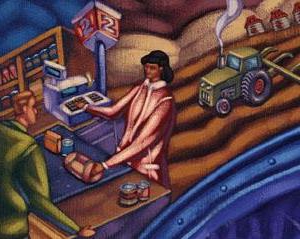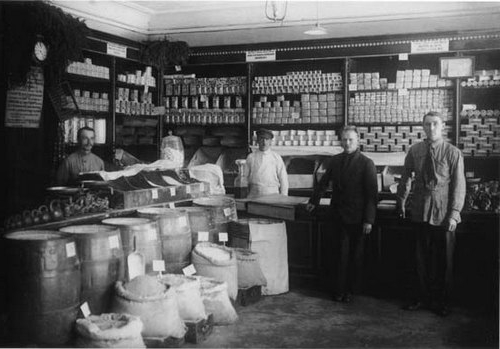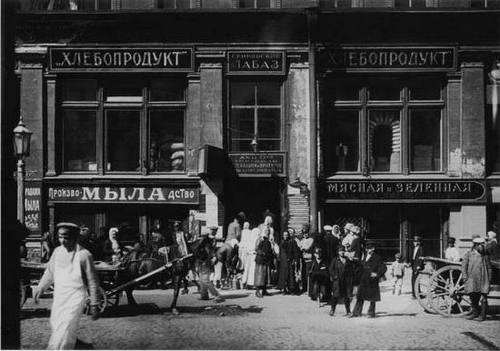Consumer cooperation involves the voluntary association of individuals and legal entities on the basis of membership. Its goal is to meet the needs of subjects in services and goods. The initial property of such associations is formed from share contributions. Let us further consider how the development of consumer cooperation took place. 
Origin
The history of consumer cooperation began in the 19th century. The birthplace of the first associations was Great Britain. At that time, consumer cooperation enterprises were opened by philanthropists. They sought to improve working conditions and the situation of workers. From 1820-1830 the workers themselves became owners of cooperative stores, bakeries, and mills. The created associations made it possible to purchase products at reduced prices. In 1844, a cooperative was opened by English weavers, the principles of the formation of which became the basis for subsequent enterprises of this category. These principles include the following provisions:
- Small shares.
- Equality among all cooperators and the presence of one vote for each.
- A limited number of shares for each member of the association.
- Sales of products are carried out at reasonable market prices and in cash.
- The cost of goods is the same for everyone (including for those who are not members of the association).
Consumer Cooperation Organizations in the USSR
In Soviet times, trade and procurement associations became widespread. Agricultural consumer cooperation that existed in the USSR solved a number of urgent problems. Among them, in particular, were questions on:
- Implementations. Retail trade in rural areas was carried out mainly due to consumer cooperation.
- Procurement. Formed associations acquired materials and raw materials, wild mushrooms, berries and fruits, and medicinal herbs from state farms, collective farms, and the population.
- Production. The system of consumer cooperation contributed to the development of the food industry (based on local agricultural products) and the release of non-food products (from agricultural and other local raw materials).
By 1990, associations served about 40% of the population. Their members were about 30 million people. The associations accounted for 1/4 of retail commodity turnover, about 1/2 of the potato harvest, 1/3 of vegetable purchases, and more than a third of bread production. Today, about 20-25 consumer cooperatives operate in the country.
Fundamentals of modern associations
Russian consumer cooperation today is a diversified socio-economic structure. The purpose of its functioning is the satisfaction of individual, social and other needs of member members in services and goods. In addition, consumer cooperation in Russia provides services to the financial interests of producers of products, united in it. Along with this, a certain benefit of the remaining participants is achieved. 
Features of consumer cooperation
One of the distinguishing features of the structure under consideration is a specific combination of social and economic functions. It is from this complex that the features of the formation and improvement of forms of cooperation proceed. The management structure combines two principles. One of them - the legal form acts as the legalized basis for the association of an economic entity that has the rights of a legal entity.He carries out the production and sale of services and goods, using the property assigned to him. The second principle is formed by successively subordinate and simultaneously operating management bodies. The structure is regulated by the Law on Consumer Cooperation.
Structural specificity
Consumer cooperation includes the following management schemes:
- In the structure of the "union-union".
- Inside society.
- In the "union-union" system.
The organizational form acts as a structural element that:
- Provides legal regulation economic activity associations.
- Includes society in a single economic space.
- Secures the management of people and processes at the organizational level.
- Establishes a scheme of external and internal financial interactions between participants in production operations.
- Regulates the mechanism of the relationship between professional management and public administration.

Social status
Characterized by the distinguishing features listed above, consumer cooperation has a certain degree of identity. Each association is a non-profit structure that performs public tasks. At the same time, the enterprise plans its economic activities on the basis of cooperative ideology, values and principles, which determines its potential and advantages in relation to other market entities.
Acting as a non-profit, the association fixes and fixes the sphere of economic interactions between the administration and shareholders on issues related to the sale of common property. Along with this, consumer cooperation establishes a procedure for interconnecting with the environment. To it, in particular, include municipal power structures and the state. This interaction is provided through insurance and financial companies, the tax service and so on. In this regard, consumer cooperation is seen as the only structure that closely integrates public interest with social groups.
Structure elements
The regulations on consumer cooperation in the Russian Federation characterize it as a complex of societies and unions formed to meet the material and other needs of their participants. In this regard, the following elements are distinguished:
- Agricultural associations engaged in the purchase, processing and marketing of raw materials.
- Specialized societies that build subsidiary farms, garages, houses for their members, are engaged in capital construction, provide loans and loans, and also provide consulting, household and other services.
- Associations engaged in production, procurement, sales and other activities, including catering.
- Business companies educational, medical and other institutions, faith partnerships as well as enterprises that can themselves act as participants in cooperatives or investors.
- Unions (district, provincial, regional, republican, Center Union).

Self-organization
The systemic nature of consumer cooperation allows us to formulate its basic properties. They, in fact, constitute the content of the social and economic functions of the structure. One of these properties is self-organization. It is the main way to form cooperatives of any kind. Self-organization is based on the initiative and personal resources of citizens, which they combine voluntarily to solve pressing issues. It is this mechanism that allows us to concentrate and introduce into the economic turnover unused reserves at the national, regional and local levels in order to meet the current needs of the population and shareholders themselves as soon as possible.
Structural
The systemicity property implies that certain forms of consumer associations (societies and their unions) interact in a certain way with each other. This relationship is ensured by the preservation of vertical levels of control and power, communication channels and the mechanism for solving problems. This allows you to analyze the activities of various structural elements of cooperation, for example, regarding the release of goods, total labor resources, the implementation of common strategic plans, and so on.
Company specifics
Consumer association is a voluntary structure. It is formed by citizens and legal entities on a territorial basis on the basis of membership. The company unites property share contributions for the implementation of production, procurement, trade and other activities to meet the needs of material participants. This definition reflects the following specific features of associations:
- The company is a collective structure that includes citizens and legal entities on the basis of voluntary membership.
- The formation of the initial capital is carried out through the combination of participants in share of property contributions. This determines the name of the members of the companies - shareholders.
- The association conducts joint production, procurement, trade or other activities.
- The social mission of society is to meet the needs of participants of a material and other nature.

Classification
Consumer societies are divided by:
1. Territorial attribute on:
- general store;
- gorpo;
- Raipo.
2. The professional or social composition of the participants in:
- working cooperatives;
- fishing associations;
- student societies;
- student associations.
Consumer societies are considered the primary structural elements. They unite participants and form larger elements. Simply put, if there are no consumer societies, there will be no unions, and consequently, cooperation itself. The complex of associations at various levels provides a more stable legal status in the country as a whole and the region in particular. The socio-economic activity of societies in unions is better organized and secured within the market.
Structural levels
The organizational structure of consumer cooperation is based on the principle of administrative-territorial division in the country. Each association or their group is located on one or another vertical level. The first is formed by consumer societies, acting as voluntary associations of individuals (less often legal entities) in one or several settlements (cities, towns and villages). The next step is the regional unions. They are formed by associations of societies in certain areas.
At the third level are republican, regional, regional unions. At the fourth stage is the voluntary association of all the country's societies. It is represented by the Central Union. The transition from a four- to three-level structure contributes to a decrease in the number of societies and their enlargement. This, in turn, simplifies the manageability of the entire system. Most of the regional unions and associations present in them have been transformed into raypo. The main advantage of creating regional societies is the concentration of capital. This helps to consolidate the position of associations. Raipo today act as large competitive structures operating in the market. 
Members of the societies
Consumer associations and their unions as legal entities have specific control bodies and an administrative apparatus. Depending on the number of participants and the territorial location, there are:
- Societies without plots.Such small associations are formed when the number of shareholders is small and all of them can be attracted to participate in general meetings.
- Companies with plots. Such associations are created if participants live in several settlements, and the total number of members is quite large.
It should be noted that the Law "On Consumer Cooperation" does not establish limits on the number of shareholders. So, in society can consist of several hundred or thousands of participants. Today, large associations dominate. It is impossible to convene a general meeting in such societies. In this regard, to ensure the participation of all members in decision-making, cooperative plots are formed. The highest management body in such associations is the meeting of shareholders from each locality. A cooperative site can be a village, several (or one) settlements, a city street or other territorial structure, which consists of no more than 300 people.
Bodies of control and management
For a consumer society without plots, the following administrative system is characteristic:
- The highest governing body is represented by a meeting of shareholders. It is convened at least once a year.
- The representative body is the council. He is elected at a general meeting. The Council has a management function between meetings.
- The executive body is the board. It is appointed by the council and acts as a professional management structure. His tasks include managing the financial and economic activities of the association.
- The controlling body is the audit commission. She is elected at a general meeting. Its tasks include ensuring control over compliance with the statutory provisions of the association, the implementation of economic and financial activities.
Consumer society with plots includes:
- The highest administrative body is a meeting of commissioners from each territory, convened at least once a year.
- The representative body is the council.
- The executive structure is the board.
- The controlling body is the revision committee.

The difference between these structures is that in the first case, all shareholders of one company enter directly into administrative and supervisory divisions, and in the second, representatives from each section of this association. Management in consumer cooperation organizations is carried out by self-government bodies (councils, meetings, revision commissions) and professional management (board). Such a structure ensures high-quality administration of companies and allows to realize the right of each shareholder to participate in decision-making and control over their implementation.
